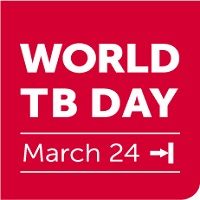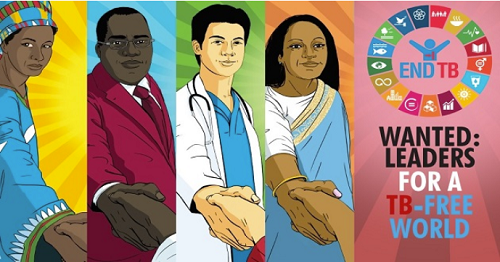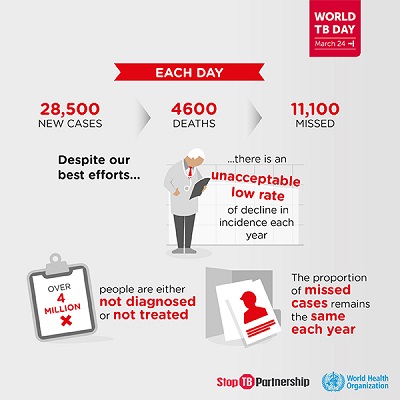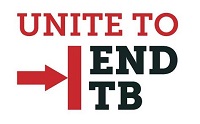24th March 2018, worldwide.
 Each year we commemorate World TB Day on March 24 to raise public awareness about the devastating health, social and economic consequences of tuberculosis (TB) and to step up efforts to end the global TB epidemic. The date marks the day in 1882 when Dr. Robert Koch announced that he had discovered the bacterium that causes TB, which opened the way towards diagnosing and curing this disease.
Each year we commemorate World TB Day on March 24 to raise public awareness about the devastating health, social and economic consequences of tuberculosis (TB) and to step up efforts to end the global TB epidemic. The date marks the day in 1882 when Dr. Robert Koch announced that he had discovered the bacterium that causes TB, which opened the way towards diagnosing and curing this disease.
Despite significant progress over the last decades, TB continues to be the top infectious killer worldwide, claiming over 4 500 lives a day. The emergence of multidrug-resistant TB (MDR-TB) poses a major health security threat and could risk gains made in the fight against TB.
The theme of World TB Day 2018 – “Wanted: Leaders for a TB-free world”– focuses on building commitment to end TB, not only at the political level with Heads of State and Ministers of Health, but at all levels from Mayors, Governors, parliamentarians and community leaders, to people affected with TB, civil society advocates, health workers, doctors or nurses, NGOs and other partners. All can be leaders of efforts to end TB in their own work or terrain.
This is a critical theme, given the political importance of the upcoming UN General Assembly high-level meeting on TB this year, which will bring together Heads of State in New York. It follows on from a very successful Ministerial Conference on Ending TB in Moscow on 16-17 November 2017 which resulted in high-level commitments from ministers and other leaders from 120 countries to accelerate progress to end TB.
World TB Day provides the opportunity to shine the spotlight on the disease and mobilize political and social commitment to accelerate progress to end TB.
Read the whole article here.
Key Facts on Tuberculosis
Tuberculosis (TB) is caused by bacteria (Mycobacterium tuberculosis) that most often affect the lungs. Tuberculosis is curable and preventable.
TB is spread from person to person through the air. When people with lung TB cough, sneeze or spit, they propel the TB germs into the air. A person needs to inhale only a few of these germs to become infected.
About one-quarter of the world’s population has latent TB, which means people have been infected by TB bacteria but are not (yet) ill with the disease and cannot transmit the disease.
People infected with TB bacteria have a 5–15% lifetime risk of falling ill with TB. However, persons with compromised immune systems, such as people living with HIV, malnutrition or diabetes, or people who use tobacco, have a much higher risk of falling ill.
Find more information on TB on the WHO-website.
Stop TB Partnership: Who They Are, What They Do
The Stop TB Partnership is leading the way to a world without tuberculosis (TB), a disease that is curable but still kills three people every minute. Founded in 2001, the Partnership’s mission is to serve every person who is vulnerable to TB and ensure that high-quality diagnosis, treatment and care is available to all who need it.
Together our 1500 partners are a collective force that is transforming the fight against TB in more than 100 countries. They include international and technical organizations, government programmes, research and funding agencies, foundations, NGOs, civil society and community groups and the private sector.
Click here to read more about Stop TB Partnership.
You might also like to visit the website of the WHO on their Global TB Programme.
TB Alliance
![]() TB Alliance is a not-for-profit organization dedicated to the discovery and development of better, faster-acting, and affordable tuberculosis drugs that are available to those who need them.
TB Alliance is a not-for-profit organization dedicated to the discovery and development of better, faster-acting, and affordable tuberculosis drugs that are available to those who need them.
We envision a world where no one dies of tuberculosis. However, this cannot be achieved without improved, faster-acting, and affordable tuberculosis drug regimens that are available to all who need them. These new cures can bring renewed health, hope, and prosperity to millions. Since our inception in 2000, TB Alliance has led the global search for and development of new TB regimens, catalyzing the field and convening cross-sector partnerships to forge the progress that is urgently needed for better TB treatments.
Visit the TB Alliance website here or subscribe to their newsletter.
Published in GI-Mail 03/2018 (English edition). Sign up for GI-Mail here. 
Tip: More up to date educational events can be found online in the Education Database »medicine & health«.



